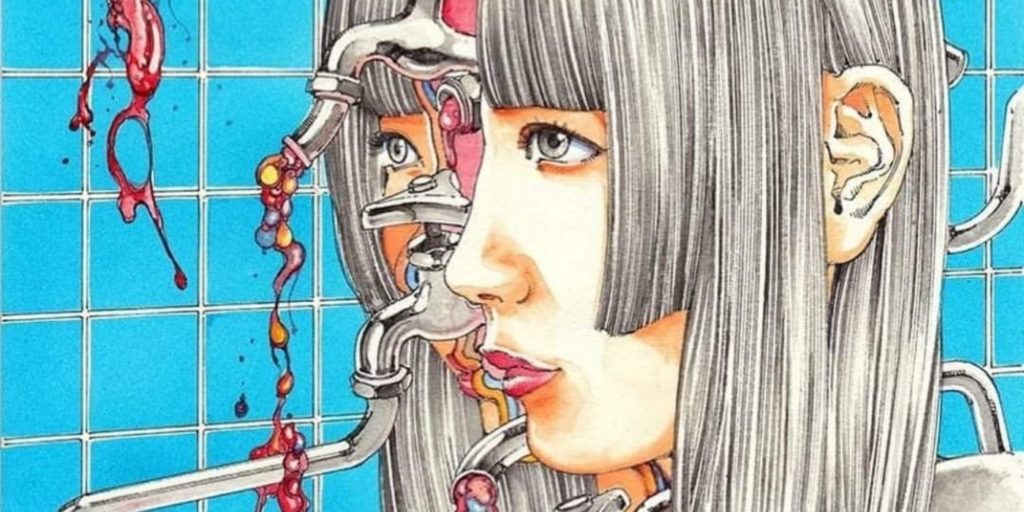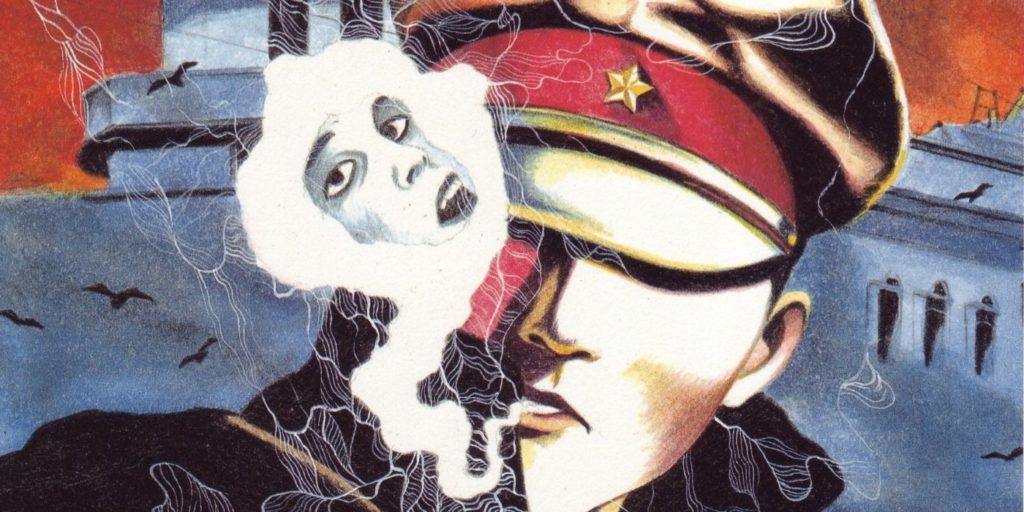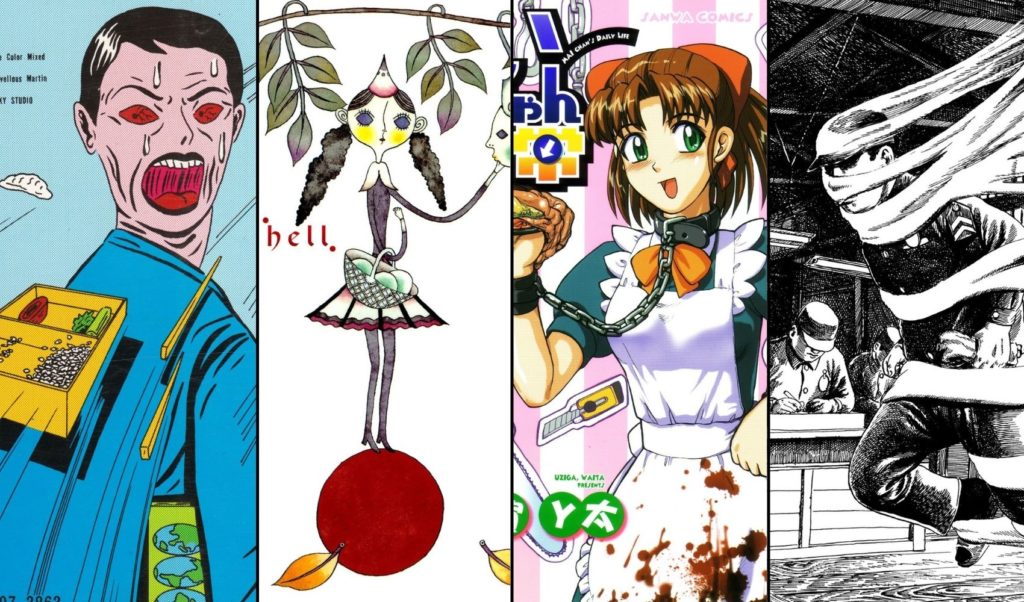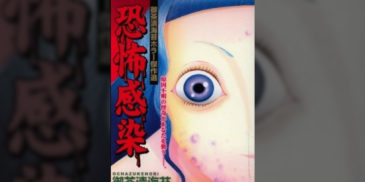
Japanese ‘erotic grotesque nonsense’, often abbreviated to ‘ero guro’ or ‘ero guro nansensu’, is a genre of art that extends to various mediums. Consequently, the genre exists as a broad statement to capture the art that puts its focus on eroticism, sexual corruption, and decadence.
The art style is not unique to Japan, but is one rooted within its history. Going back all the way to the 16th century in the erotic/pornographic ukiyo-e prints known as Shunga (“spring pictures”). These drawings, which were deemed to be ‘educational’, continued to push boundaries leading to more extreme depiction of sex including the infamous work from Hokusai, Taka to Ama (Diving Girl and Octopus).

Other societal norms also worked to both push boundaries and create a trend in art, such as ‘news nishiki-e‘. These were widely circulated news prints of the 17th century, depicting violent crime with lurid and graphic detail to every extent of these acts. These works would further speak to the normalization of art in exploring the extremes of human behavior through artistic channels.
There are many other contributing factors to the acceptance of the core elements to ‘erotic grotesque’, with the style extending to other forms of media such as film and music. Thus, the artists included in this list should act as a gateway into a larger avenue of self exploration of the artistic movement.
Shintaro Kago – Exploding Beauty

Kago has been publishing comics since 1988 when he made his debut with a submission to COMIC BOX. However, the artists started to enter the Western consciousness on a larger scale when he was highlighted in Vice Magazine and given the apt description of ‘fashionable paranoia’, an endearing Western take on his particular brand of grotesque. Since then, he has become one of the most published mangaka within the genre, having seen English editions through Hollow Press, Fantagraphics and Denpa.
The success is largely attributed to his colour artwork versus his manga releases, that capture the oversaturation of materialism. It is not uncommon to see his subjects bursting to reveal toys, technology or ‘fashionable’ items as their facial features bend to make way for these items. His manga, while less catchy, is best described as dark humor with a penchant for nudity and gore.
My own personal experience with Kago was becoming entranced in awe with the artwork, but gaining a deeper appreciation through his narrative works. I would recommend checking out Super Dimensional Love Gun first for a more affordable dive into his work before going into the collector/expensive releases.
Kago also makes these neat animations worth checking out!
Toshio Saeki – Perverse Observer

“Leave other people to draw seemingly beautiful flowers that bloom within a nice, pleasant-looking scenery,” he told Dazed in 2013. “I try instead to capture the vivid flowers that sometimes hide and sometimes grow within a shameless, immoral and horrifying dream.”
If you were to look at one definitive artist to capture the spirit of the art movement, you would be hard-pressed to pick anyone over the “Godfather of Japanese Erotica” in Toshio Saeki. Born in 1945, Sakie became a notable figure in Japan’s postwar underground scene, with a focus on exploring sexual taboos within Japanese society. Saekie was not only a pioneer in bringing the movement to the underground, but also proved the effectiveness of the genre in offering critique to societal normalcy, a commonality among the personalities included in this list.
The term of ‘perverse observer’ comes from one notable recurring theme, that of having a third party looking in as voyeurism. This gives a playful and whimsical addition to each of his pieces which compliments his style. Overall, his work exists between traditional and modern form that captures the roots and evolution of the ‘erotic grotesque’.
There are many sources dedicated to preserving and celebrating the art of Saeki, who recently passed at the age of 74 (you can read his obituary here). For a daily dose of his work there is a dedicated IG page I would recommend.
Suehiro Maruo – Twisted Traditions

Maruo exists as one of the most beloved figures within the erotic grotesque movement, and (besides Kago) has proven to be the first artist that introduced fans to the genre as a gateway. His work is also cemented in infamy as one of the regular contributors of the iconic underground magazine ‘Garo‘ that promoted alternative and art manga though the 60’s until its fold in 2002. Maruo himself was a prominent contributor in the 80’s when the magazine offered a platform for ero-guro and punk inspired artists.
What makes Maruo such an intriguing figure within the genre? While the answer may come down more to personal tastes, his embracing of traditional Japanese art reflective of woodblock paintings. Additionally, his narrative work manages to make his forms come to life with frenetic movement that captures a wonderful chaos that few others can accomplish.
With the huge fan base that Maruo carries, and his infamy for extreme art thanks to the anime adaptation of Midori: The Camilla Girl, Maruo has been sadly underrepresented for English releases of his work, with most being OOP at this point. So reach out to various publishers and let it be known, we want more Maruo! If you want to track something down for your first experience, The Laughing Vampire rests as a personal favorite of mine.
If you want to try to stomach it, you can watch the anime of Midori here.
Daisuke Ichiba – Natural Chaos
Ichiba has been an active figure of the undergrounds art scene since the 90’s, building up a following with his distinctive style that warps every day situations, injecting them with absurdism, eroticism, violence and different artistic techniques. Consequently, his work isa standout among the already diverse genre.
The term ‘natural chaos’ comes from the artist’s own statement concerning his art; “The expression that results is a natural chaos. In my work I project chaos, anarchy, anxiety, the grotesque, the absurd, and the irrational. By doing so I attain harmony. This is my art. Put simply, I paint humanity (the spirit).” His narrative work explores this idea of focusing on the natural chaos of existence and the human condition, focusing on broken figures struggling with human greed and corruption. Overall, Ichiba has carried the wonderful moniker of ‘badism’ that capture his mix of surrealism with a grotesque focus on human fallacy.
You can follow the art of Daisuke Ichiba over on Instagram or at his official page, the latter I highly recommend checking out to see the other art projects of Ichiba, which extends to photography and music. If you are looking for English translated work, Hollow Press recently released The Life of Namazuko which I can not recommend highly enough.
Namio Harakuwa – Commercial Kink

Born in Osaka in 1947, the artist worked under a pseudonym: Namio is an anagram of Naomi, the heroine in Jun’ichiro Tanizaki’s novel of the same name, with Harakuwa being inspired by a famous Japanese actress of the time, Masumi Harukawa. Harakuwa became an international figure of fetishism for his portrayals of face sitting and squashing in expressing his passion of ‘oshiri‘, meaning ‘buttocks’, revolving around the power dynamics it expresses.
While blurring the lines of fetishism and the grotesque, his artistic approach makes some uncomfortable with the extreme pressure placed on the back and necks of its subjects as they become submissive to women up to triple their size and weight. Ultimately, the work exists more as a point of reference in-between genres and how extreme ‘sexualization’ can work within the mainstream as well as the underground.
Sadly, actual printed work of his is rare and pricey at the time of writing this article. One cool site for Japanese content, Aka Tako, currently has some of his work available which you can check out here.
Honorable Mentions and Outliers

Here are some noteworthy names that either work within the artform, or exist just outside the sphere but are still a point of interest in terms of content.
Kazuchi Hanawa: When looking at Maruo, the influence from Hanawa is apparent in both style and substance. Therefore, fans of Maruo are bound to appreciate this mangaka in equal measure. The only major hindrance comes from limited access to his work in English, making Maruo the better candidate to explore traditional inspired ‘ero guro’. His work may be hard to come by, but a great collection that includes his work along with many who worked for the legendary Garo magazine is Comics Underground Japan.
Waita Uziga: There is an extreme side to the genre, one in which any form of depravity goes and violent sexual acts are common place. I bring this up because it does act as a bit of a warning when researching this content on your own. With that said, Uziga presents the best of the sub-genre with Mai Chan’s Daily Life being his most accessible work.
Yoshikazu Ebisu: You would be hard pressed to find panels that would reflect Ebisu as a purveyor in the genre, but this mangakas’ comedic take on the Japanese everyman does touch on the cultures attitudes towards sexuality. Largely, the dark and twisted humor of Ebisu may speak to those who enjoy the humorous side of the grotesque. If you are looking to indulge in Ebisu’s particular brand of dark humor, check out the releases from Breakdown Press.
Nishioka Kyoudai: Moniker of a brother sister duo, the two create these dark fantastical worlds where sexual perversion is not uncommon. Adversely, one of there more notable works, Kami no Kodomo, explores the life of a sociopath murder with a broken view of sexuality. The duo marks on of my favorite underexplored work in this list, but to have called it essential would have just been self-serving. Please make sure to check them out.
*all site links for purchases are for love of the genre and guiding others to find good material, we get no affiliate kick backs from supporting any of these sites.
More Manga Reviews:
Geungsi Kawaii (2023) Manga Review – Kawaii Desu Ne
Geungsi Kawaii is an action thriller manga, Written and illustrated by Singaporean artist Sean Lam, with additional writing from Junzi. The manga is part of Sean’s Geungsi series, working as…
Sadako at the End of the World Manga Review – Like a Ray of Hope During the Apocalypse
Sadako at the End of the World balances delicately between a cute slice-of-life story and a new entry into the Ring franchise that holds up as true canon. Featuring supervision…
Fear Infection (Kyoufu Kansen) Manga Review – Visions of Childhood Terrors
I am always on the lookout for more extreme and challenging horror manga as a fan of work that pushes those boundaries of what is acceptable as entertainment. That said,…
Magical Girl Site (2013) Manga Review – It’s Not Madoka and That’s Completely Okay
At some point in history, the magical girl genre existed as the pinnacle of wholesomeness. Yet, Madoka Magica became a staple as the deconstruction of it. At this time, it…
Geungsi Gangster (2023) Manga Review – Gangster’s Paradise
Geungsi Gangster is an action thriller manga, written and illustrated by Singaporean artist Sean Lam, with additional writing from Junzi. The manga is part of Sean’s Geungsi series, working as…
Drifting Classroom Manga Review – Don’t Look a Drift Horse in the Mouth
The Drifting Classroom (aka Hyouryuu Kyoushitsu) is a horror manga series released all the way back in 1972 by Weekly Shonen Sunday. This piece of art is written and illustrated…






